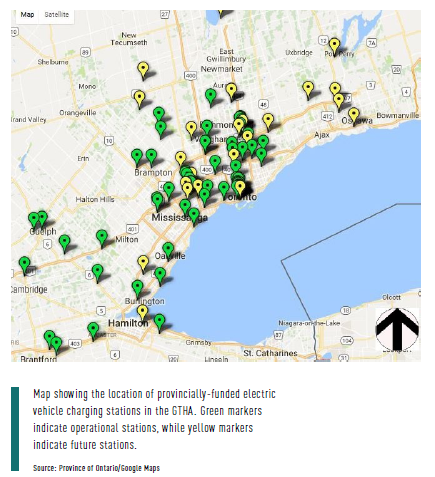
ELECTRIC VEHICLE NETWORK: SLOW PROGRESS
NRU
Dominik Matusik
Aug. 16, 2017
The provincial government has made ambitious commitments to encourage people to use electric vehicles. However, infrastructure has lagged behind aggressive targets.
In 2016, the provincial government committed, through the EVCO program, to funding 500 charging stations at 250 locations, in partnership with 24 private and public organizations. While the goal was to have all chargers operational by March of this year, only about 60 per cent of the network is running as of August.
Ministry of Transportation spokesperson Bob Nichols said, in an email to NRU, that the provincial government and its partners have been making progress on building the stations, and they should all be operational by the fall.
“There are 24 public- and private-sector recipients of EVCO funding who are contributing to the creation of a network of electric vehicle charging stations across Ontario,” Nichols wrote. “ … Each EVCO recipient has had to deal with unique circumstances, such as geography, available infrastructure and utility services. Our goal for a network of electric vehicle charging stations across the province is moving ahead. As of August 4, 60 per cent of the network is inservice and more come online every week.”
In 2009, the government had committed to a goal of 1 in 20 cars on the road being electric by 2020, a target Ontario will almost certainly not meet. In 2016, it was changed to 1 in 20 cars sold by 2020 being electric. A scaled down yet still ambitious target.
Canadian Urban Transit Research & Innovation Consortium executive director and CEO Josipa Petrunic told NRU that the provincial electric vehicle goals can only be met if they are accompanied by carbon-pricing and policies to discourage gas-burning cars.
“Similar targets are only achievable if set within the context where carbon is heavily priced, and gasoline and diesel vehicles are properly priced. So if the target, as it was in 2009, was the simple displacement because people would wake up one day and realize they wanted electric cars that was not feasible ... and still isn’t. So any electric vehicle target we set for 2040 or 2050 based just on people adopting [electric vehicles], without any other constraint on gasoline or diesel cars is not feasible. But adopting a target, including a very ambitious target by 2030 or 2025 is entirely achievable if you pursue a panoply of pricing policies that involve pricing carbon heavily, penalizing the use of gasoline and diesel cars, restricting roadways for those vehicles and ultimately killing the car. Not just killing gasoline or diesel, but killing the car.”
However, the provincial government is confident the 2020 goal will be met, according to an email from Ministry of the Environment and Climate Change spokesperson Gary Wheeler.
“The target ... for 5 per cent of sales / leases to be electric and hydrogen vehicles by 2020 reflects a viable goal, which accounts for current market trends in the uptake of the new technologies and sales volumes in the province... After years of slow progress, we saw a significant increase in electric vehicles in the province in 2016, with nearly 10,000 such vehicles registered in Ontario.”
Additionally, changes to the building code, which will come into effect on January 1, 2018, will require parking in new residential construction to be built electric vehicle-ready.
Petrunic adds that Ontario, along with Quebec, is a leader among Canadian jurisdictions on electric vehicle policy.
A new report by Ontario environmental commissioner Diane Saxe outlines the province’s progress in reducing its energy use, and highlights its lack of policies discouraging petroleum use, particularly in the transportation sector, as a major weakness.

